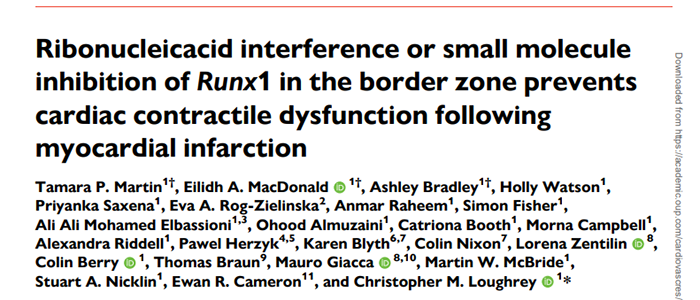New paper on Runx1 and MI
Published: 10 August 2023
New paper published in Cardiovascular Research (2023)
Ribonucleicacid interference or small molecule inhibition of Runx1 in the border zone prevents cardiac contractile dysfunction following myocardial infarction

Abstract
Myocardial infarction (MI) is a major cause of death worldwide. Effective treatments are required to improve recovery of cardiac function following MI, with the aim of improving patient outcomes and preventing progression to heart failure. The perfused but hypocontractile region bordering an infarct is functionally distinct from the remote surviving myocardium and is a determinant of adverse remodelling and cardiac contractility. Expression of the transcription factor RUNX1 is increased in the border zone 1-day after MI, suggesting potential for targeted therapeutic intervention.
This study sought to investigate whether an increase in RUNX1 in the border zone can be therapeutically targeted to preserve contractility following MI.
In this work we demonstrate that Runx1 drives reductions in cardiomyocyte contractility, calcium handling, mitochondrial density, and expression of genes important for oxidative phosphorylation. Both tamoxifen-inducible Runx1-deficient and essential co-factor common β subunit (Cbfβ)-deficient cardiomyocyte-specific mouse models demonstrated that antagonizing RUNX1 function preserves the expression of genes important for oxidative phosphorylation following MI. Antagonizing RUNX1 expression via short-hairpin RNA interference preserved contractile function following MI. Equivalent effects were obtained with a small molecule inhibitor (Ro5-3335) that reduces RUNX1 function by blocking its interaction with CBFβ.
Our results confirm the translational potential of RUNX1 as a novel therapeutic target in MI, with wider opportunities for use across a range of cardiac diseases where RUNX1 drives adverse cardiac remodelling.
First published: 10 August 2023

